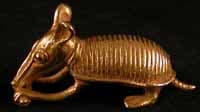Gold Sculpture of an Armadillo, 10th Century CE - 15th Century CE
Gold
2
FJ.6164
Further images
In Spanish, armadillo means, 'little armored one.' The armadillo truly is one of the most spectacular and unusual appearing creatures in the animal kingdom. Looking somewhat like a cross between...
In Spanish, armadillo means, "little armored one." The armadillo truly is one of the most spectacular and unusual appearing creatures in the animal kingdom. Looking somewhat like a cross between an anteater and a turtle, the armadillo features a tough, thick bard outer shell that protects it from the harsh elements and potential predators. When threatened, the armadillo curls itself into a hall, becoming virtually indestructible. Subsisting on a diet of insects and invertebrates, the armadillo can often be spotted burrowing through the ground in search of grubs. Occasionally, they are known to eat berries and bird eggs. Due to their digging habits, they are sometimes known "gravediggers," due to the legendary belief that they were eating the bodily remains of the deceased. The corncob that this gold armadillo holds in his mouth is surely not a part of his natural diet. Perhaps there is a mythological explanation for this unusual pairing. Maybe this sculpture represents and ancient Pre-Columbian parable that bas been lost to us. Gorgeously detailed, this charming sculpture stuns us with its artistic beauty and tantalizes our imaginations with its mysterious meaning. Clearly, there is something here greater than we are able to comprehend. Most likely, this small sculpture is a symbol and self-preservation that would be a valuable les son for any culture or civilization.





